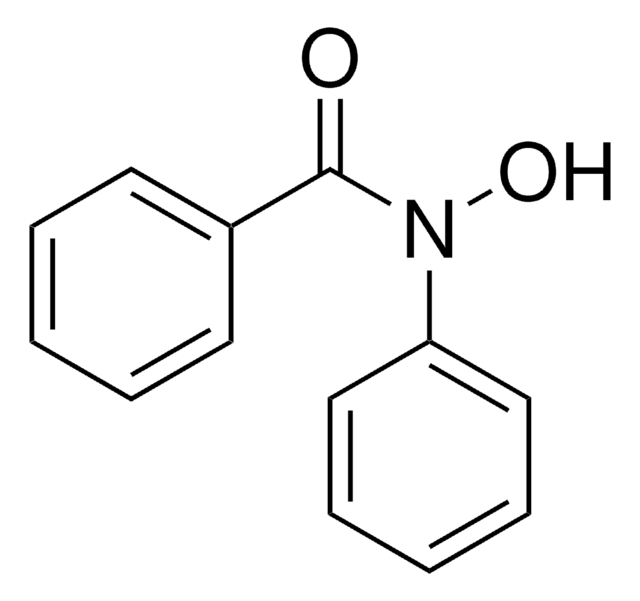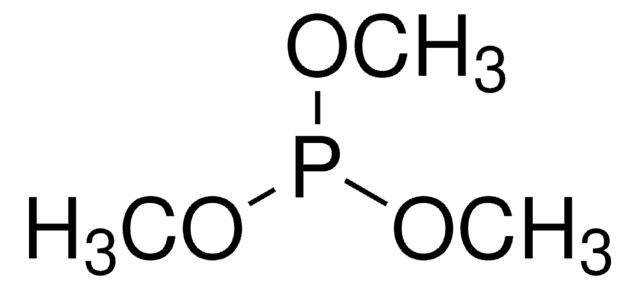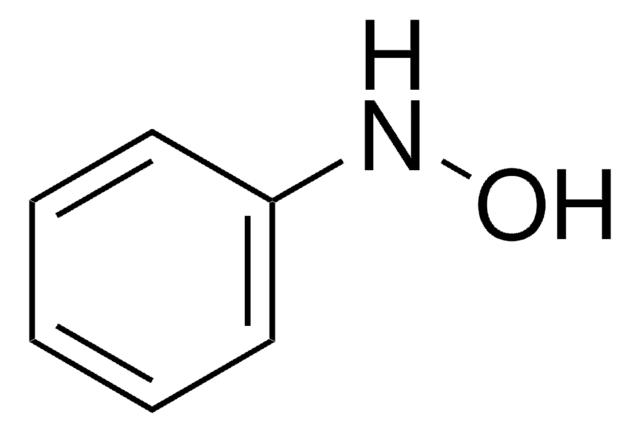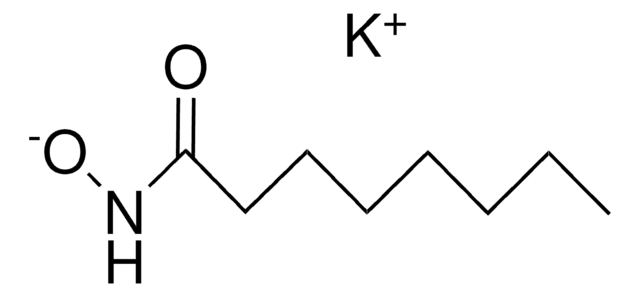412260
Benzhydroxamic acid
99%
Sinónimos:
N-Hydroxybenzamide
Iniciar sesiónpara Ver la Fijación de precios por contrato y de la organización
About This Item
Fórmula lineal:
C6H5CONHOH
Número de CAS:
Peso molecular:
137.14
Beilstein:
1907585
Número CE:
Número MDL:
Código UNSPSC:
12352100
ID de la sustancia en PubChem:
NACRES:
NA.22
Productos recomendados
Nivel de calidad
Análisis
99%
mp
126-130 °C (lit.)
solubilidad
1 M NaOH: soluble 50 mg/mL, clear, colorless
grupo funcional
amine
phenyl
temp. de almacenamiento
2-8°C
cadena SMILES
ONC(=O)c1ccccc1
InChI
1S/C7H7NO2/c9-7(8-10)6-4-2-1-3-5-6/h1-5,10H,(H,8,9)
Clave InChI
VDEUYMSGMPQMIK-UHFFFAOYSA-N
¿Está buscando productos similares? Visita Guía de comparación de productos
Categorías relacionadas
Descripción general
Benzhydroxamic acid (BHA) reacts with BiPh3 or Bi(O(t)Bu)3 to afford novel mono- and di-anionic hydroxamato complexes, having anti-bacterial activity against Helicobacter pylori. Three-dimensional structure of recombinant horseradish peroxidase-BHA complex has been studied.
Aplicación
Benzhydroxamic acid may be employed for the Pd-catalyzed synthesis of benzisoxazolones.
Código de clase de almacenamiento
11 - Combustible Solids
Clase de riesgo para el agua (WGK)
WGK 3
Punto de inflamabilidad (°F)
Not applicable
Punto de inflamabilidad (°C)
Not applicable
Equipo de protección personal
Eyeshields, Gloves, type N95 (US)
Elija entre una de las versiones más recientes:
¿Ya tiene este producto?
Encuentre la documentación para los productos que ha comprado recientemente en la Biblioteca de documentos.
Los clientes también vieron
A Henriksen et al.
Biochemistry, 37(22), 8054-8060 (1998-06-12)
The three-dimensional structure of recombinant horseradish peroxidase in complex with BHA (benzhydroxamic acid) is the first structure of a peroxidase-substrate complex demonstrating the existence of an aromatic binding pocket. The crystal structure of the peroxidase-substrate complex has been determined to
Swetlana Gez et al.
Inorganic chemistry, 44(8), 2934-2943 (2005-04-12)
A new family of relatively stable Cr(V) complexes, [Cr(V)O(L)(2)](-) (LH(2) = RC(O)NHOH, R = Me, Ph, 2-HO-Ph, or HONHC(O)(CH(2))(6)), has been obtained by the reactions of hydroxamic acids with Cr(VI) in polar aprotic solvents. Similar reactions in aqueous solutions led
Fernando Ruy et al.
Journal of bioenergetics and biomembranes, 38(2), 129-135 (2006-10-21)
Candida parapsilosis mitochondria contain three respiratory chains: the classical respiratory chain (CRC), a secondary parallel chain (PAR) and an "alternative" oxidative pathway (AOX). We report here the existence of similar pathways in C. albicans. To observe the capacity of each
Florian Thaler et al.
Journal of medicinal chemistry, 53(2), 822-839 (2009-12-19)
The histone deacetylases (HDACs) are able to regulate gene expression, and histone deacetylase inhibitors (HDACi) emerged as a new class of agents in the treatment of cancer as well as other human disorders such as neurodegenerative diseases. In the present
Henrik R Hallingbäck et al.
Biochemistry, 45(9), 2940-2950 (2006-03-01)
The oxidation of melatonin by the mammalian myeloperoxidase (MPO) provides protection against the damaging effects of reactive oxygen species. Indole derivatives, such as melatonin and serotonin, are also substrates of the plant horseradish peroxidase (HRP), but this enzyme exhibits remarkable
Nuestro equipo de científicos tiene experiencia en todas las áreas de investigación: Ciencias de la vida, Ciencia de los materiales, Síntesis química, Cromatografía, Analítica y muchas otras.
Póngase en contacto con el Servicio técnico









